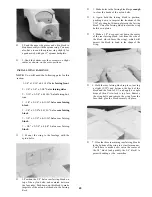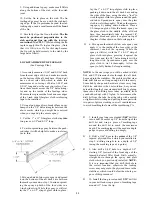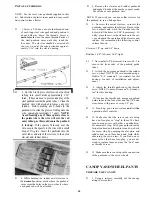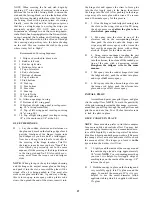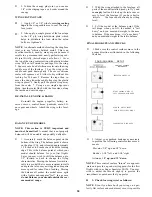
9. Determine from the detail drawing on the
wing plan where the axle will enter the pant.
Drill a 3/16" diameter hole (5/32" for nose gear
pant) at this location. Drill only through the
side of the pant that has the ply screw
plate.
10. Slip the wheel pant on the landing gear
wire, position the pant so it is parallel with
the fuselage, and mark the gear location on
the side of the pant. Notice that the bend in
the landing gear prevents you from pushing
the pant all the way on.
11. Remove the pant and carefully carve away
the area of the pant at the bend in the landing
gear, to allow the landing gear to fit flush
against the side of the pant.
12. Check the pant alignment carefully, then
attach the wheel pant to the landing gear using
the nylon clip and two #4 x 1/2" screws. NOTE:
After installing these screws once, remove
them and cut 1/8" off the pointed ends to avoid
puncturing the tires.
D 13. Remove the wheel pants and sand the entire
outside surface lightly with 320 grit sandpaper.
D 14. Spray on a coat of primer, then sand smooth.
D 15. Paint the wheel pants with a fuelproof paint
to match your covering material, and trim ac-
cording to your preference.
FINISHING
ADDITIONAL FUELPROOFING
If you have not already done so, make sure the
entire engine compartment is completely fuelproof.
Also fuelproof any wood that will not be covered and
which may be exposed to glow fuel residue, such as
the landing gear block slots and the wing saddle.
Use epoxy thinned with alcohol, polyester finishing
resin or fuelproof paint.
BALANCE THE AIRPLANE LATERALLY
SPECIAL NOTE: Do not confuse this procedure
with "checking the C.G." or "balancing the
airplane fore and aft". That very important step
will be covered later in the manual.
Now that you have the basic airframe nearly
completed, this is a good time to balance the airplane
laterally (side-to-side). Here is how to do it:
D 1. Temporarily attach the wing and engine
(with muffler) to the fuselage.
D 2. With the wing level, lift the model by the
engine propeller shaft and the bottom of the
rudder (this may require two people). Do this
several times.
D 3. If one wing always drops when you lift, it
means that side is heavy. Balance the airplane
by gluing weight to the other wing tip.
FINAL SANDING
Check over the entire structure carefully, in-
specting for any poorly glued joints, gaps and "dings".
Apply additional glue and/or balsa filler as neces-
sary, then sand the entire fuselage smooth using
progressively finer grades of sandpaper.
COVERING
Because it is assumed that you have had some
previous model building experience, we won't go into
detail in regard to the covering procedure, except for
a few important comments.
D 1. Before covering, fuelproof and paint the in-
side of the engine compartment.
D 2. We like to glue #400 grit wet-or-dry
sandpaper to the cockpit floor, which gives it
a nice flat black finish.
36








